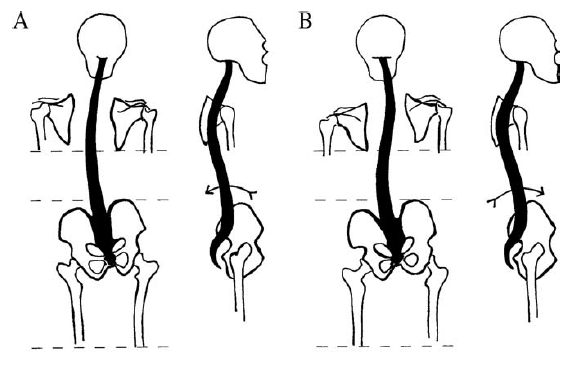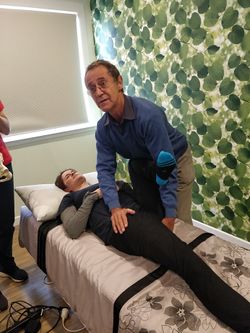Sacroiliac Joint Pain: Difference between revisions
No edit summary |
(general content addition) |
||
| Line 1: | Line 1: | ||
{{stub}} | {{stub}} | ||
{{ | ==Anatomy== | ||
{{main|Sacroiliac Joint Anatomy}} | |||
The sacroiliac joint is a diarthrodial synovial joint, and only the anterior aspect is a true synovial joint. The posterior aspect is a syndesmosis that consists of the gluteus medius, gluteus minimus, sacroiliac ligaments, and piriformis. {{#pmid:20667026|vanelderen}} | |||
== Pelvic Malalignment == | ==Epidemiology== | ||
The sacroiliac joint accounts for around 16% to 30% of causes of chronic low back pain. <ref name="vanelderen"/> | |||
==Clinical Assessment== | |||
=== Pelvic Malalignment === | |||
Timgren et al assessed pelvic asymmetry in neurologic patients with symptoms that weren't explained by a neurological diagnosis. They found pelvic asymmetry in 87%. Reestablishment and maintenance of symmetry correlated with improvement in pain and function. An average of 3.7 appointments was needed. They found the following patterns. <ref>{{#pmid:16949945}}</ref> | Timgren et al assessed pelvic asymmetry in neurologic patients with symptoms that weren't explained by a neurological diagnosis. They found pelvic asymmetry in 87%. Reestablishment and maintenance of symmetry correlated with improvement in pain and function. An average of 3.7 appointments was needed. They found the following patterns. <ref>{{#pmid:16949945}}</ref> | ||
| Line 36: | Line 43: | ||
Schamberger’s rule of the five Ls, which relates to the side of the anteriorly rotated innominate: “Leg Lengthens Lying, Landmarks Lower” (supine vs long sitting) <ref>Wolf Schamberger. The Malalignment Syndrome 2nd Edition. Churchill Livingstone. 2012</ref> | Schamberger’s rule of the five Ls, which relates to the side of the anteriorly rotated innominate: “Leg Lengthens Lying, Landmarks Lower” (supine vs long sitting) <ref>Wolf Schamberger. The Malalignment Syndrome 2nd Edition. Churchill Livingstone. 2012</ref> | ||
==Manual Therapy== | ==Treatment== | ||
===Manual Therapy=== | |||
Alignment can be reacquired through various means such as muscle energy techniques, and mobilisation with movement. | Alignment can be reacquired through various means such as muscle energy techniques, and mobilisation with movement. | ||
===Mulligan Techniques=== | ====Mulligan Techniques==== | ||
;Anterior Innominate Rotation | |||
The most common malalignment is anterior rotation. This can usually be easily corrected with a mobilisation with movement technique called anterior innominate extension in lying mobilisation with movement. The sacrum is stabilised, the innominate is rotated and glided posteriorly, while the patient extends in lying. Ensure mobilisation is a combination of glide +/- rotation of the innominate with opposing forces on the sacrum. This technique often corrects posterior rotation, too. | The most common malalignment is anterior rotation. This can usually be easily corrected with a mobilisation with movement technique called anterior innominate extension in lying mobilisation with movement. The sacrum is stabilised, the innominate is rotated and glided posteriorly, while the patient extends in lying. Ensure mobilisation is a combination of glide +/- rotation of the innominate with opposing forces on the sacrum. This technique often corrects posterior rotation, too. | ||
| Line 52: | Line 61: | ||
</gallery> | </gallery> | ||
;Mulligan Videos | |||
* [[Media:Anterior_Innominate_Extension_in_Lying_MWM.mp4|Anterior Innominate Extension in Lying MWM]] | * [[Media:Anterior_Innominate_Extension_in_Lying_MWM.mp4|Anterior Innominate Extension in Lying MWM]] | ||
| Line 62: | Line 71: | ||
* [[Media:Posterior_Innominate_Side_Bending_in_Standing_MWM.mp4|Posterior Innominate Side Bending in Standing MWM]] | * [[Media:Posterior_Innominate_Side_Bending_in_Standing_MWM.mp4|Posterior Innominate Side Bending in Standing MWM]] | ||
===Muscle Energy Techniques=== | ====Muscle Energy Techniques==== | ||
Pelvic asymmetries can also be corrected with muscle energy techniques. | Pelvic asymmetries can also be corrected with muscle energy techniques. | ||
;Anterior Innominate Rotation | |||
The technique can be visualised via the image below where the origin and insertion of the hamstrings are reversed to pull and rotate the innominate. Ensure to lean cranially, and allow some abduction of the ipsilateral hip. Stabilise the contralateral ASIS. Reach the end range of hip flexion and complete a muscle energy technique. The patient can treat themselves by grasping under their knees and resisting thigh extension, alternating on both sides. This again produces a correctional rotational force on the pelvis. | The technique can be visualised via the image below where the origin and insertion of the hamstrings are reversed to pull and rotate the innominate. Ensure to lean cranially, and allow some abduction of the ipsilateral hip. Stabilise the contralateral ASIS. Reach the end range of hip flexion and complete a muscle energy technique. The patient can treat themselves by grasping under their knees and resisting thigh extension, alternating on both sides. This again produces a correctional rotational force on the pelvis. | ||
| Line 72: | Line 81: | ||
[[File:Muscle Energy Pelvis Posterior Rotation.jpg|250px]] | [[File:Muscle Energy Pelvis Posterior Rotation.jpg|250px]] | ||
=== HVLA techniques === | ==== HVLA techniques ==== | ||
High-velocity and low-amplitude thrust technique can be applied through the ankle on the side of the dysfunctional SI joint | High-velocity and low-amplitude thrust technique can be applied through the ankle on the side of the dysfunctional SI joint | ||
===Precision Treatment=== | |||
{{main|Sacroiliac Joint Precision Treatment}} | |||
The sacroiliac joint can treated with radiofrequency neurotomy after a confirmatory single or dual diagnostic block. Cooled radiofrequency neurotomy has an evidence base, while traditional radiofrequency does not. | |||
== Article Downloads == | == Article Downloads == | ||
| Line 79: | Line 92: | ||
==References== | ==References== | ||
<references/> | |||
{{Reliable sources}} | |||
[[Category:Sacroiliac Joint]] | [[Category:Sacroiliac Joint]] | ||
[[Category:Stubs]] | [[Category:Stubs]] | ||
Revision as of 06:53, 23 August 2020
Anatomy
- Main article: Sacroiliac Joint Anatomy
The sacroiliac joint is a diarthrodial synovial joint, and only the anterior aspect is a true synovial joint. The posterior aspect is a syndesmosis that consists of the gluteus medius, gluteus minimus, sacroiliac ligaments, and piriformis. [1]
Epidemiology
The sacroiliac joint accounts for around 16% to 30% of causes of chronic low back pain. [1]
Clinical Assessment
Pelvic Malalignment
Timgren et al assessed pelvic asymmetry in neurologic patients with symptoms that weren't explained by a neurological diagnosis. They found pelvic asymmetry in 87%. Reestablishment and maintenance of symmetry correlated with improvement in pain and function. An average of 3.7 appointments was needed. They found the following patterns. [2]
| Innominate | A. Posterior rotation | B. Anterior Rotation |
|---|---|---|
| Iliac Crest | Elevated ↑ | Elevated ↑ |
| ASIS | Elevated ↑ | Depressed ↓ |
| PSIS | Depressed ↓ | Elevated ↑ |
| scapula | Depressed ↓ | Elevated ↑ |
| leg | Longer ↑ | Shorter ↓ |
| 10-15mm lift | Increased crest difference ↑ | Reduced crest difference ↓ |
| Spinal curvature | C type scoliosis | S type scoliosis |
| C0-C1 function | Symmetric rotation in flexion | Restricted rotation in flexion |
All changes are in reference the ipsilateral side.
Rising of the crest upon anterior SI rotation is paradoxical, and its explanation cannot be reduced to a two-dimensional model.
Schamberger’s rule of the five Ls, which relates to the side of the anteriorly rotated innominate: “Leg Lengthens Lying, Landmarks Lower” (supine vs long sitting) [3]
Treatment
Manual Therapy
Alignment can be reacquired through various means such as muscle energy techniques, and mobilisation with movement.
Mulligan Techniques
- Anterior Innominate Rotation
The most common malalignment is anterior rotation. This can usually be easily corrected with a mobilisation with movement technique called anterior innominate extension in lying mobilisation with movement. The sacrum is stabilised, the innominate is rotated and glided posteriorly, while the patient extends in lying. Ensure mobilisation is a combination of glide +/- rotation of the innominate with opposing forces on the sacrum. This technique often corrects posterior rotation, too.
- Mulligan Videos
Muscle Energy Techniques
Pelvic asymmetries can also be corrected with muscle energy techniques.
- Anterior Innominate Rotation
The technique can be visualised via the image below where the origin and insertion of the hamstrings are reversed to pull and rotate the innominate. Ensure to lean cranially, and allow some abduction of the ipsilateral hip. Stabilise the contralateral ASIS. Reach the end range of hip flexion and complete a muscle energy technique. The patient can treat themselves by grasping under their knees and resisting thigh extension, alternating on both sides. This again produces a correctional rotational force on the pelvis.
HVLA techniques
High-velocity and low-amplitude thrust technique can be applied through the ankle on the side of the dysfunctional SI joint
Precision Treatment
- Main article: Sacroiliac Joint Precision Treatment
The sacroiliac joint can treated with radiofrequency neurotomy after a confirmatory single or dual diagnostic block. Cooled radiofrequency neurotomy has an evidence base, while traditional radiofrequency does not.
Article Downloads
References
- ↑ 1.0 1.1 Vanelderen et al.. 13. Sacroiliac joint pain. Pain practice : the official journal of World Institute of Pain 2010. 10:470-8. PMID: 20667026. DOI.
- ↑ Timgren & Soinila. Reversible pelvic asymmetry: an overlooked syndrome manifesting as scoliosis, apparent leg-length difference, and neurologic symptoms. Journal of manipulative and physiological therapeutics 2006. 29:561-5. PMID: 16949945. DOI.
- ↑ Wolf Schamberger. The Malalignment Syndrome 2nd Edition. Churchill Livingstone. 2012
Literature Review
- Reviews from the last 7 years: review articles, free review articles, systematic reviews, meta-analyses, NCBI Bookshelf
- Articles from all years: PubMed search, Google Scholar search.
- TRIP Database: clinical publications about evidence-based medicine.
- Other Wikis: Radiopaedia, Wikipedia Search, Wikipedia I Feel Lucky, Orthobullets,







